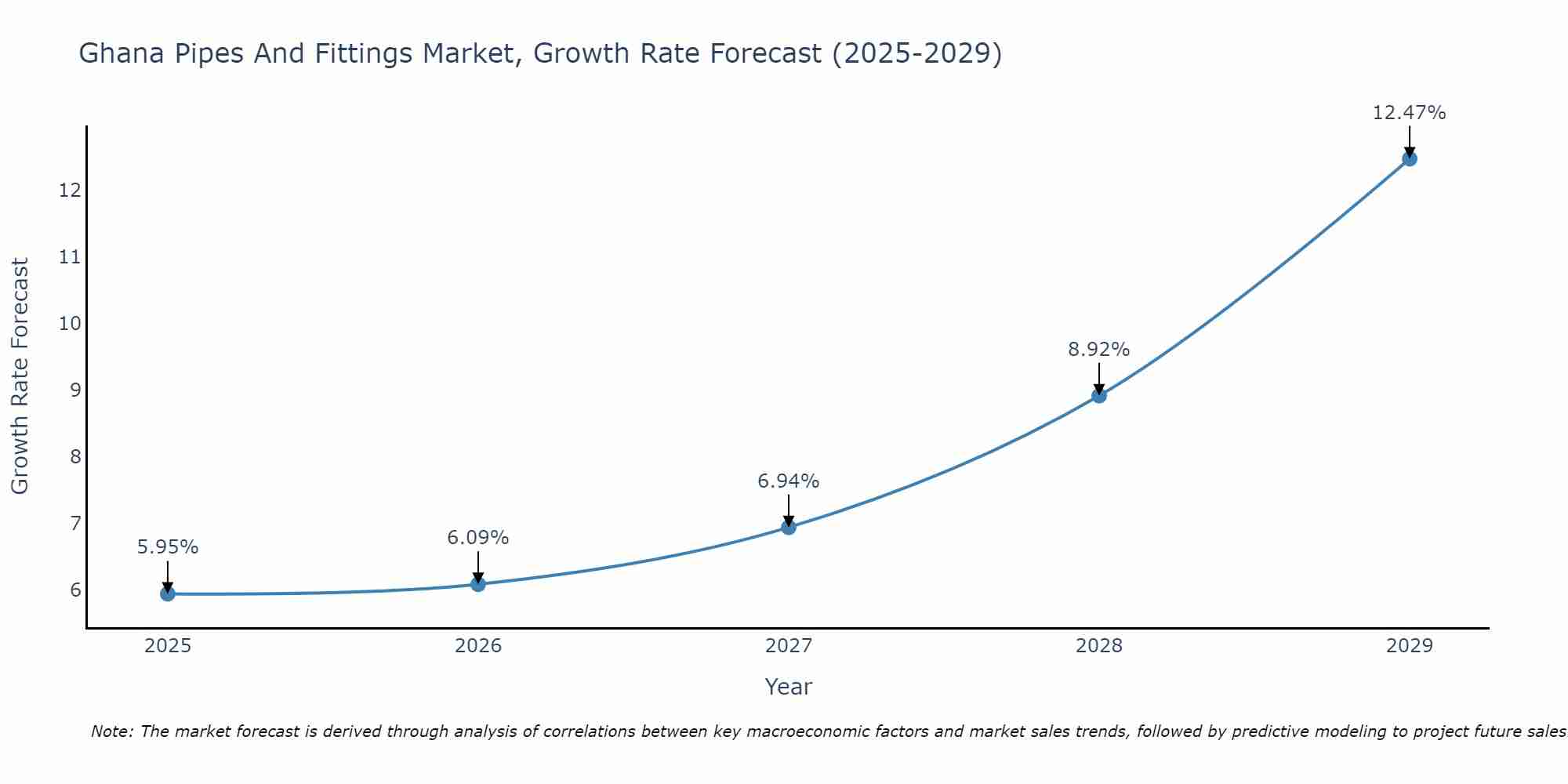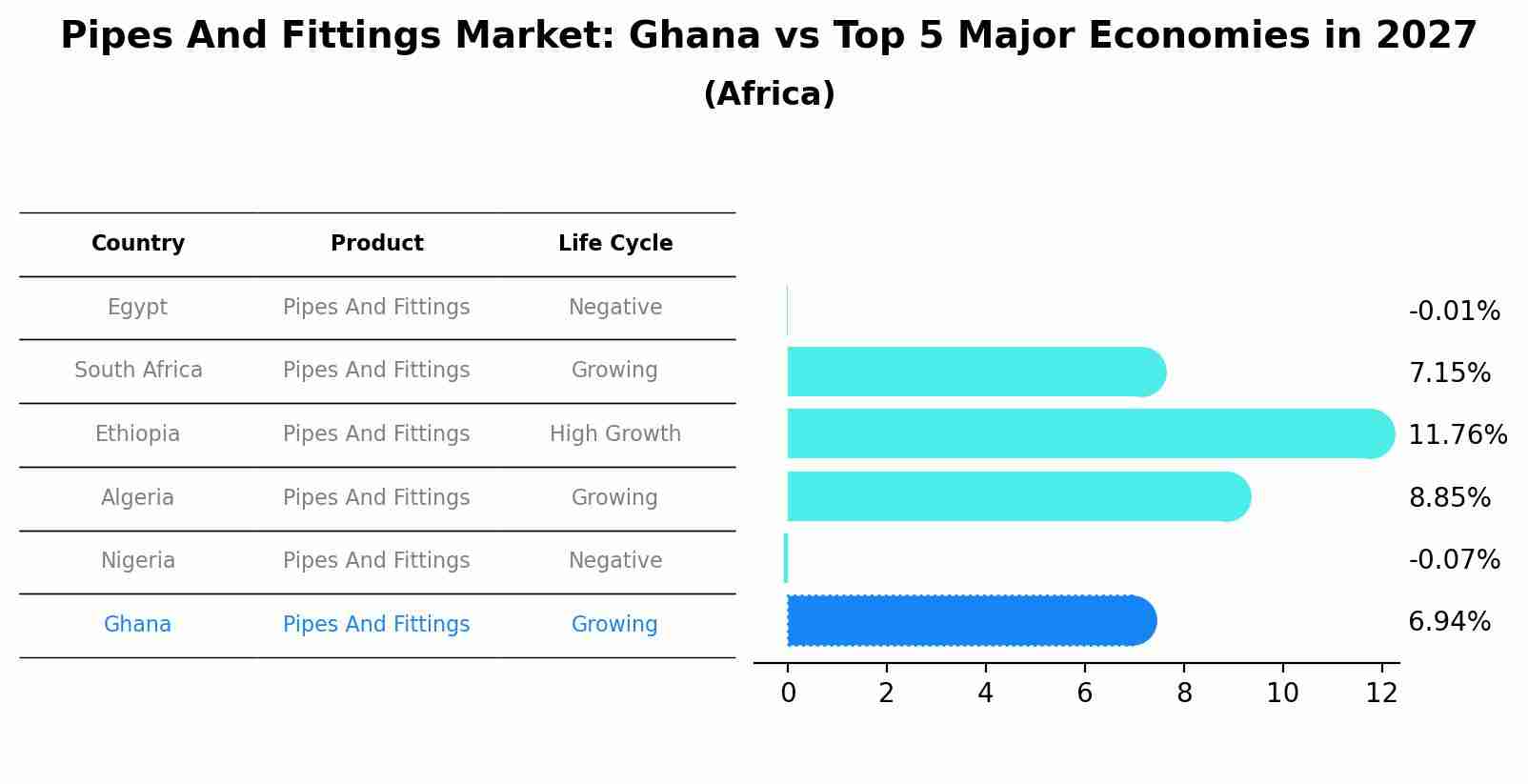Ghana Pipes And Fittings Market (2025-2031) Outlook | Size, Revenue, Industry, Value, Trends, Share, Growth, Forecast, Analysis & Companies
| Product Code: ETC377516 | Publication Date: Aug 2022 | Updated Date: Jul 2025 | Product Type: Market Research Report | |
| Publisher: 6Wresearch | Author: Bhawna Singh | No. of Pages: 75 | No. of Figures: 35 | No. of Tables: 20 |
Ghana Pipes And Fittings Market Size Growth Rate
The Ghana Pipes And Fittings Market is poised for steady growth rate improvements from 2025 to 2029. Commencing at 5.95% in 2025, growth builds up to 12.47% by 2029.

Pipes And Fittings Market: Ghana vs Top 5 Major Economies in 2027 (Africa)
Ghana's Pipes And Fittings market is anticipated to experience a growing growth rate of 6.94% by 2027, reflecting trends observed in the largest economy Egypt, followed by South Africa, Ethiopia, Algeria and Nigeria.

Ghana Pipes And Fittings Market Synopsis
The Ghana pipes and fittings market is experiencing steady growth driven by infrastructure development, urbanization, and industrialization in the country. The market is characterized by a wide range of products including PVC pipes, polyethylene pipes, steel pipes, and various types of fittings. Key factors influencing market growth include government investments in water and sanitation projects, expansion of the construction industry, and increasing demand for irrigation systems in agriculture. Local manufacturers and international companies are actively competing in the market, offering products of varying quality and price points. The market is also witnessing a shift towards more sustainable and environmentally friendly products, with a growing emphasis on water conservation and efficient distribution systems. Overall, the Ghana pipes and fittings market presents opportunities for both domestic and international players looking to capitalize on the country`s infrastructure development.
Ghana Pipes And Fittings Market Trends
Currently, the Ghana pipes and fittings market is experiencing a trend towards the adoption of more sustainable and environmentally friendly materials such as HDPE (High-Density Polyethylene) and PVC (Polyvinyl Chloride) pipes. This shift is driven by increasing awareness of the importance of water conservation and environmental protection. Additionally, there is a growing demand for durable and high-quality pipes and fittings to support infrastructure development projects in the country, particularly in sectors such as construction, agriculture, and mining. Market players are also focusing on innovation and product development to meet the evolving needs of customers, such as offering leak-proof and corrosion-resistant solutions. Overall, the market is expected to continue growing as Ghana invests in modernizing its infrastructure and improving access to clean water and sanitation services.
Ghana Pipes And Fittings Market Challenges
The Ghana Pipes and Fittings Market faces several challenges including increasing competition from imported products, inconsistent quality standards, limited access to raw materials, and inadequate infrastructure for distribution. The influx of cheaper imported products often puts pressure on local manufacturers to compete on pricing, impacting their profitability. In addition, the lack of standardized quality control measures makes it difficult for consumers to trust the durability and reliability of locally produced pipes and fittings. Limited availability of raw materials locally also hinders production capacity and scalability for manufacturers. Furthermore, the inadequate infrastructure for distribution and logistics in Ghana adds to the overall challenges faced by players in the market, impacting timely delivery and increasing costs. Addressing these challenges will be crucial for the sustainable growth of the Ghana Pipes and Fittings Market.
Ghana Pipes And Fittings Market Investment Opportunities
The Ghana Pipes and Fittings Market presents promising investment opportunities due to the country`s growing construction sector and increasing urbanization. Investing in the manufacturing and distribution of high-quality pipes and fittings to meet the demand for residential, commercial, and industrial construction projects can be lucrative. Additionally, there is a need for innovative and sustainable piping solutions to address issues such as water scarcity and environmental concerns. Collaborating with local construction companies, developers, and government agencies can provide strategic partnerships for market entry and growth. With proper market research and understanding of local regulations and trends, investors can capitalize on the expanding infrastructure development in Ghana and establish a successful presence in the Pipes and Fittings Market.
Jordan Agar Market Government Policies
The Ghanaian government has implemented various policies related to the Pipes and Fittings market to promote local manufacturing and ensure quality standards. These policies include the Ghana Standards Authority Act, which sets out regulations for the quality of pipes and fittings produced and imported into the country. Additionally, the government has introduced tax incentives and subsidies to support local manufacturers in the industry. The Ghana Investment Promotion Center Act also encourages foreign investment in the sector to boost technology transfer and innovation. Overall, these policies aim to enhance the competitiveness of the Ghana Pipes and Fittings market, ensure product quality and safety, and drive growth in the industry.
Ghana Pipes And Fittings Market Future Outlook
The Ghana pipes and fittings market is expected to experience steady growth in the coming years driven by infrastructure development projects, urbanization, and increasing demand for clean water supply and sanitation systems. The construction sector in Ghana is witnessing significant growth, leading to a rising demand for pipes and fittings for various applications such as water supply, drainage, and irrigation. Additionally, the government`s focus on improving water and sanitation infrastructure across the country is expected to boost the market further. As the economy continues to expand and industrial activities increase, the demand for high-quality pipes and fittings is likely to rise, presenting opportunities for both local manufacturers and international players looking to enter the Ghanaian market. Overall, the future outlook for the Ghana pipes and fittings market appears promising with a positive growth trajectory expected in the foreseeable future.
Key Highlights of the Report:
- Ghana Pipes And Fittings Market Outlook
- Market Size of Ghana Pipes And Fittings Market, 2024
- Forecast of Ghana Pipes And Fittings Market, 2031
- Historical Data and Forecast of Ghana Pipes And Fittings Revenues & Volume for the Period 2021 - 2031
- Ghana Pipes And Fittings Market Trend Evolution
- Ghana Pipes And Fittings Market Drivers and Challenges
- Ghana Pipes And Fittings Price Trends
- Ghana Pipes And Fittings Porter's Five Forces
- Ghana Pipes And Fittings Industry Life Cycle
- Historical Data and Forecast of Ghana Pipes And Fittings Market Revenues & Volume By Material Type for the Period 2021 - 2031
- Historical Data and Forecast of Ghana Pipes And Fittings Market Revenues & Volume By Steel Pipe for the Period 2021 - 2031
- Historical Data and Forecast of Ghana Pipes And Fittings Market Revenues & Volume By Copper Pipe for the Period 2021 - 2031
- Historical Data and Forecast of Ghana Pipes And Fittings Market Revenues & Volume By Aluminum Pipe for the Period 2021 - 2031
- Historical Data and Forecast of Ghana Pipes And Fittings Market Revenues & Volume By Glass Pipe for the Period 2021 - 2031
- Historical Data and Forecast of Ghana Pipes And Fittings Market Revenues & Volume By Plastic Pipe for the Period 2021 - 2031
- Historical Data and Forecast of Ghana Pipes And Fittings Market Revenues & Volume By Polyvinyl Chloride (Pvc) Pipe for the Period 2021 - 2031
- Historical Data and Forecast of Ghana Pipes And Fittings Market Revenues & Volume By End Use for the Period 2021 - 2031
- Historical Data and Forecast of Ghana Pipes And Fittings Market Revenues & Volume By Domestic for the Period 2021 - 2031
- Historical Data and Forecast of Ghana Pipes And Fittings Market Revenues & Volume By Industrial Applications for the Period 2021 - 2031
- Ghana Pipes And Fittings Import Export Trade Statistics
- Market Opportunity Assessment By Material Type
- Market Opportunity Assessment By End Use
- Ghana Pipes And Fittings Top Companies Market Share
- Ghana Pipes And Fittings Competitive Benchmarking By Technical and Operational Parameters
- Ghana Pipes And Fittings Company Profiles
- Ghana Pipes And Fittings Key Strategic Recommendations
Frequently Asked Questions About the Market Study (FAQs):
- Single User License$ 1,995
- Department License$ 2,400
- Site License$ 3,120
- Global License$ 3,795
Search
Related Reports
- ASEAN Bearings Market (2025-2031) | Strategy, Consumer Insights, Analysis, Investment Trends, Opportunities, Growth, Size, Share, Industry, Revenue, Segments, Value, Segmentation, Supply, Forecast, Restraints, Outlook, Competition, Drivers, Trends, Demand, Pricing Analysis, Competitive, Strategic Insights, Companies, Challenges
- Europe Flooring Market (2025-2031) | Outlook, Share, Industry, Trends, Forecast, Companies, Revenue, Size, Analysis, Growth & Value
- Saudi Arabia Manlift Market (2025-2031) | Outlook, Size, Growth, Trends, Companies, Industry, Revenue, Value, Share, Forecast & Analysis
- Uganda Excavator, Crane, and Wheel Loaders Market (2025-2031) | Strategy, Consumer Insights, Analysis, Investment Trends, Opportunities, Growth, Size, Share, Industry, Revenue, Segments, Value, Segmentation, Supply, Forecast, Restraints, Outlook, Competition, Drivers, Trends, Demand, Pricing Analysis, Competitive, Strategic Insights, Companies, Challenges
- Rwanda Excavator, Crane, and Wheel Loaders Market (2025-2031) | Strategy, Consumer Insights, Analysis, Investment Trends, Opportunities, Growth, Size, Share, Industry, Revenue, Segments, Value, Segmentation, Supply, Forecast, Restraints, Outlook, Competition, Drivers, Trends, Demand, Pricing Analysis, Competitive, Strategic Insights, Companies, Challenges
- Kenya Excavator, Crane, and Wheel Loaders Market (2025-2031) | Strategy, Consumer Insights, Analysis, Investment Trends, Opportunities, Growth, Size, Share, Industry, Revenue, Segments, Value, Segmentation, Supply, Forecast, Restraints, Outlook, Competition, Drivers, Trends, Demand, Pricing Analysis, Competitive, Strategic Insights, Companies, Challenges
- Angola Excavator, Crane, and Wheel Loaders Market (2025-2031) | Strategy, Consumer Insights, Analysis, Investment Trends, Opportunities, Growth, Size, Share, Industry, Revenue, Segments, Value, Segmentation, Supply, Forecast, Restraints, Outlook, Competition, Drivers, Trends, Demand, Pricing Analysis, Competitive, Strategic Insights, Companies, Challenges
- Israel Intelligent Transport System Market (2025-2031) | Strategy, Consumer Insights, Analysis, Investment Trends, Opportunities, Growth, Size, Share, Industry, Revenue, Segments, Value, Segmentation, Supply, Forecast, Restraints, Outlook, Competition, Drivers, Trends, Demand, Pricing Analysis, Competitive, Strategic Insights, Companies, Challenges
- Uganda Precast and Aggregate Market (2025-2031) | Strategy, Consumer Insights, Analysis, Investment Trends, Opportunities, Growth, Size, Share, Industry, Revenue, Segments, Value, Segmentation, Supply, Forecast, Restraints, Outlook, Competition, Drivers, Trends, Demand, Pricing Analysis, Competitive, Strategic Insights, Companies, Challenges
- Australia IT Asset Disposal Market (2025-2031) | Strategy, Consumer Insights, Analysis, Investment Trends, Opportunities, Growth, Size, Share, Industry, Revenue, Segments, Value, Segmentation, Supply, Forecast, Restraints, Outlook, Competition, Drivers, Trends, Demand, Pricing Analysis, Competitive, Strategic Insights, Companies, Challenges
Industry Events and Analyst Meet
Our Clients
Whitepaper
- Middle East & Africa Commercial Security Market Click here to view more.
- Middle East & Africa Fire Safety Systems & Equipment Market Click here to view more.
- GCC Drone Market Click here to view more.
- Middle East Lighting Fixture Market Click here to view more.
- GCC Physical & Perimeter Security Market Click here to view more.
6WResearch In News
- Doha a strategic location for EV manufacturing hub: IPA Qatar
- Demand for luxury TVs surging in the GCC, says Samsung
- Empowering Growth: The Thriving Journey of Bangladesh’s Cable Industry
- Demand for luxury TVs surging in the GCC, says Samsung
- Video call with a traditional healer? Once unthinkable, it’s now common in South Africa
- Intelligent Buildings To Smooth GCC’s Path To Net Zero













